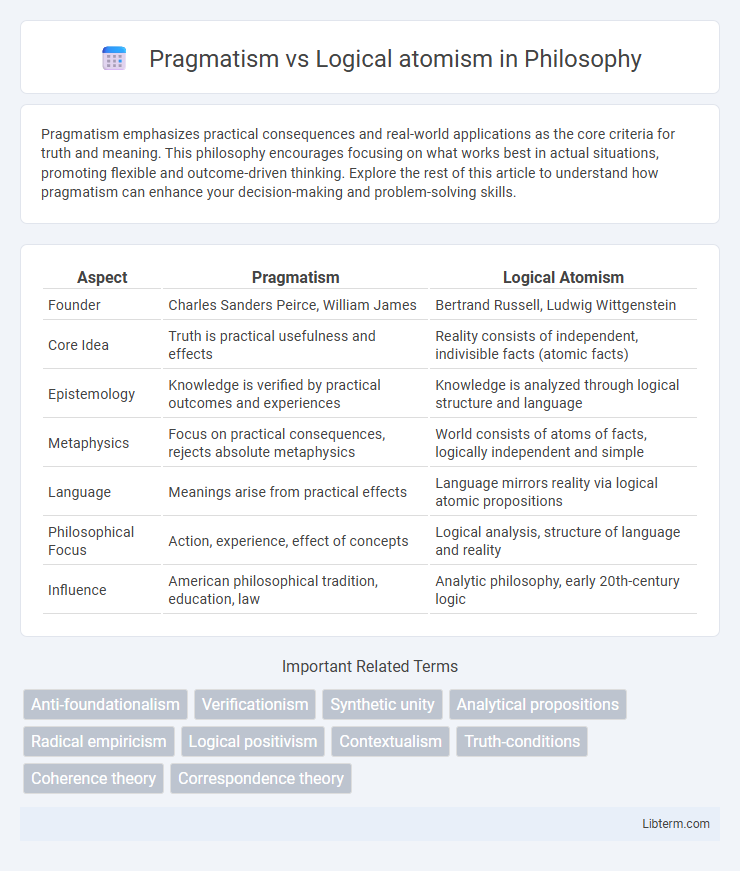Pragmatism emphasizes practical consequences and real-world applications as the core criteria for truth and meaning. This philosophy encourages focusing on what works best in actual situations, promoting flexible and outcome-driven thinking. Explore the rest of this article to understand how pragmatism can enhance your decision-making and problem-solving skills.
Table of Comparison
| Aspect | Pragmatism | Logical Atomism |
|---|---|---|
| Founder | Charles Sanders Peirce, William James | Bertrand Russell, Ludwig Wittgenstein |
| Core Idea | Truth is practical usefulness and effects | Reality consists of independent, indivisible facts (atomic facts) |
| Epistemology | Knowledge is verified by practical outcomes and experiences | Knowledge is analyzed through logical structure and language |
| Metaphysics | Focus on practical consequences, rejects absolute metaphysics | World consists of atoms of facts, logically independent and simple |
| Language | Meanings arise from practical effects | Language mirrors reality via logical atomic propositions |
| Philosophical Focus | Action, experience, effect of concepts | Logical analysis, structure of language and reality |
| Influence | American philosophical tradition, education, law | Analytic philosophy, early 20th-century logic |
Introduction to Pragmatism and Logical Atomism
Pragmatism emphasizes the practical consequences and usefulness of beliefs as the key criteria for truth, rooted in the works of Charles Sanders Peirce and William James. Logical atomism, pioneered by Bertrand Russell and Ludwig Wittgenstein, seeks to analyze complex propositions into their simplest components to uncover the logical structure of language and reality. Both philosophies address the nature of truth and knowledge but diverge in their approaches: pragmatism through practical applicability and logical atomism through formal logical analysis.
Historical Background and Key Proponents
Pragmatism emerged in the late 19th century primarily through the works of Charles Sanders Peirce, William James, and John Dewey, focusing on practical consequences and the utility of beliefs as the basis of meaning and truth. Logical atomism, developed in the early 20th century by Bertrand Russell and Ludwig Wittgenstein, emphasized the analysis of language and reality into atomic facts to clarify philosophical problems through logic. Both movements significantly influenced analytic philosophy but differed in their approach to meaning, truth, and the role of language.
Fundamental Tenets of Pragmatism
Pragmatism emphasizes the practical consequences and utility of beliefs as the core criteria for truth, contrasting with Logical Atomism's focus on analysis of language into atomic facts. Central to Pragmatism is the idea that concepts and theories must be evaluated based on their measurable effects in experience and problem-solving contexts. This approach rejects absolute certainty, advocating for truth as a dynamic process shaped by inquiry and human action.
Core Principles of Logical Atomism
Logical atomism centers on the belief that reality consists of discrete, atomic facts that can be analyzed through logical structures, emphasizing clarity and precision in language to reflect these facts. It advocates for breaking down complex propositions into simpler components, aiming to establish a direct correspondence between language and reality. Pragmatism, by contrast, prioritizes the practical consequences and usefulness of beliefs over strict logical analysis, focusing on ideas as tools for action rather than fixed truths.
Epistemological Approaches: Experience vs. Analysis
Pragmatism emphasizes knowledge gained through practical experience and the consequences of ideas in real-world applications, framing truth as what works effectively in practice. Logical atomism, in contrast, prioritizes logical analysis and the decomposition of propositions into atomic facts, aiming for precise, formal knowledge structures grounded in language and logic. These epistemological approaches differ fundamentally, with pragmatism valuing empirical verification and utility, while logical atomism seeks clarity through analytical reduction and logical positivism.
Language and Meaning in Both Philosophies
Pragmatism views language as a dynamic tool for practical problem-solving, emphasizing meaning through use and consequences in real-world contexts. Logical atomism treats language as a rigid structure composed of logically independent atomic propositions that mirror facts, aiming for clarity and precision in meaning. While pragmatism prioritizes functional and evolving semantics, logical atomism seeks fixed, objective truth conditions through atomic linguistic elements.
The Role of Truth: Coherence vs. Correspondence
Pragmatism defines truth through coherence, emphasizing the practical consequences and consistency of beliefs within experiential frameworks, where truth is verified by usefulness and problem-solving effectiveness. Logical atomism upholds truth as a matter of correspondence, asserting that propositions must directly reflect objective facts and the world's atomic facts to be true. This distinction highlights pragmatism's flexible, context-driven notion of truth versus logical atomism's rigid, fact-based validation.
Practical Implications and Applications
Pragmatism emphasizes the practical consequences of beliefs and theories, making it highly applicable in fields like education, law, and policy-making where outcomes guide decision-making. Logical atomism, rooted in analytical philosophy, focuses on breaking down complex propositions into simpler components, which aids in formal logic, computer science, and linguistic analysis by enhancing clarity and precision. Both frameworks influence problem-solving but pragmatism prioritizes utility and adaptability, whereas logical atomism prioritizes structural coherence and foundational accuracy.
Criticisms and Limitations Compared
Pragmatism faces criticism for its perceived relativism and lack of strict criteria for truth, often challenged for prioritizing practical consequences over objective reality. Logical atomism encounters limitations due to its reductionist approach, breaking down language and reality into atomic facts, which critics argue oversimplifies complex concepts and ignores context. Compared to Pragmatism, Logical atomism is less flexible in addressing evolving meanings, while Pragmatism struggles with consistency and formal rigor in philosophical analysis.
Conclusion: Reconciling Pragmatism and Logical Atomism
Pragmatism and Logical Atomism both aim to clarify meaning but from differing angles: Pragmatism emphasizes practical consequences and experience, while Logical Atomism focuses on logical structure and discrete facts. Reconciling these views involves integrating Pragmatism's contextual understanding of truth with Logical Atomism's rigorous analysis of language and reality. This synthesis promotes a dynamic epistemology that respects empirical verification alongside precise logical decomposition.
Pragmatism Infographic

 libterm.com
libterm.com